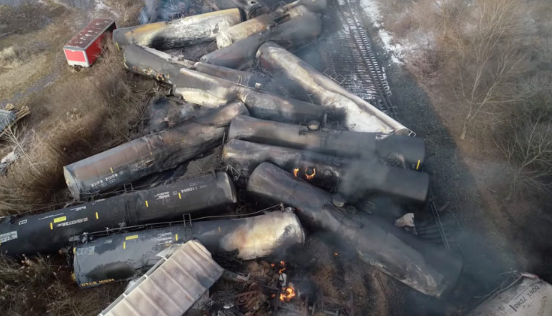The Latest News
Ohio Toxic Spill Risks Contaminating Local Water Supplies for 5M People

A train disaster on the border between Ohio and Pennsylvania resulted in a poisonous spill, which could be seen pouring toward the local water intakes of more than five million individuals whose drinking water originates from the Ohio River.
According to Environmental Protection Agency (EPA) officials, hazardous chemicals seeped into the near area Sulphur Run waterway and made their way downstream into the Ohio River during the initial phase of the incident, which saw emergency responders forced to burn vinyl chloride off to prevent an explosion.
However, they have emphasized that they are convinced that drinking water would not be contaminated because they have put preventative measures in place, as have local water boards that get their supply from the significant U.S. river.
When a cargo train carrying hazardous materials derailed close to the Ohio hamlet of East Palestine, it caused a massive fire that forced emergency personnel to empty five cars of vinyl chloride and carry out a controlled burn, releasing hazardous fumes into the atmosphere. Additionally, harmful compounds have been found in the soil and water nearby by EPA officials.
According to Tiffany Kavalec, head of the Ohio EPA’s surface water division, “The spill did flow to the Ohio River during that initial slug, but the Ohio River is very large and it’s a water body that’s able to dilute the pollutants pretty quickly.”
She said that the “contaminant plume” is thought to be traveling downstream at a speed of about one mile per hour and that the Ohio EPA had been tracking it in conjunction with the Ohio River Valley Water Sanitation Commission (ORSANCO).
According to Kavalec,”ORSANCO’s tracking allows for potential closing of drinking water intakes to allow the majority of the chemicals to pass. This strategy along with drinking water treatment…are both effective at addressing these contaminants.”
Contractors for the rail operator, Norfolk Southern, were “actively aerating” the water, and the containment perimeter reached 1.3 miles to Leslie Run. According to Kavalec, Sulphur Run “remains contaminated but we’re confident it’s contained.”
Leslie Run, which was also aerated, contained residual debris, according to Kirk Kollar of the Ohio EPA.
On February 10, the EPA discovered low concentrations of butyl acrylate and ethylhexyl acrylate in Leslie Run. By the moment the water approached the north fork of Little Beaver Creek and Little Beaver Creek, butyl acrylate and ethylhexyl acrylate had both dissolved to undetectable quantities. Vinyl chloride, a known carcinogen, had not been found in the streams, according to Kavalec.
Little Beaver Creek travels further south until it reaches the Ohio River just beyond the state line, close to Glasgow, Pennsylvania. The Ohio River then flows past Cincinnati before crossing the borders between West Virginia and Ohio, then Kentucky.
88 percent of the drinking water for the greater Cincinnati area comes from the Ohio River via the Miller Treatment Plant, while the remaining 12 percent comes from groundwater wells.
The Ohio River had a butyl acrylate concentration of up to 4 parts per billion over the weekend, according to Jeff Swertfeger, superintendent of water quality and treatment for the Greater Cincinnati Water Works. A concentration of 560 parts per billion is considered dangerous.
For “a little more oomph” in the extraction of contaminants, he added, the water board will be adding activated carbon, such as charcoal powder, early in their filtration procedure.
According to the Weirton Daily Times, samples of the river obtained on February 8 near Steubenville and Toronto, Ohio, revealed butyl acrylate concentrations of 1.23 parts per billion and 1 part per billion, respectively.
Marc Glass, senior environmental consultant at Downstream Strategies, who has directed state and federal projects on contamination in West Virginia, said “That would be below health-based drinking water standards, so that’s a good number to have. Zero is better, but that’s not a number that would raise concern and should be treatable if it were taken into the public drinking water system.”
While Weirton Utilities in West Virginia had discovered the contamination on February 7 and had altered the composition of its water sources, water treatment facilities in both communities had at least quadrupled their use of activated carbon.